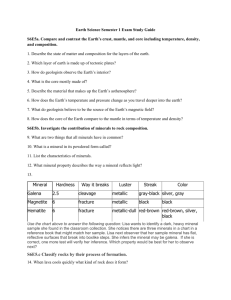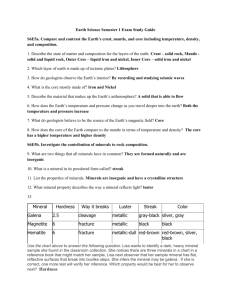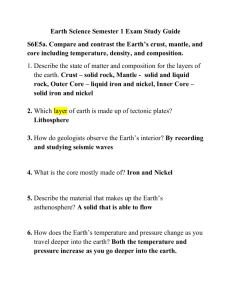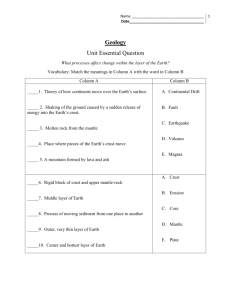6th Grade Earth Science Semester 1 Exam Study Guide
advertisement
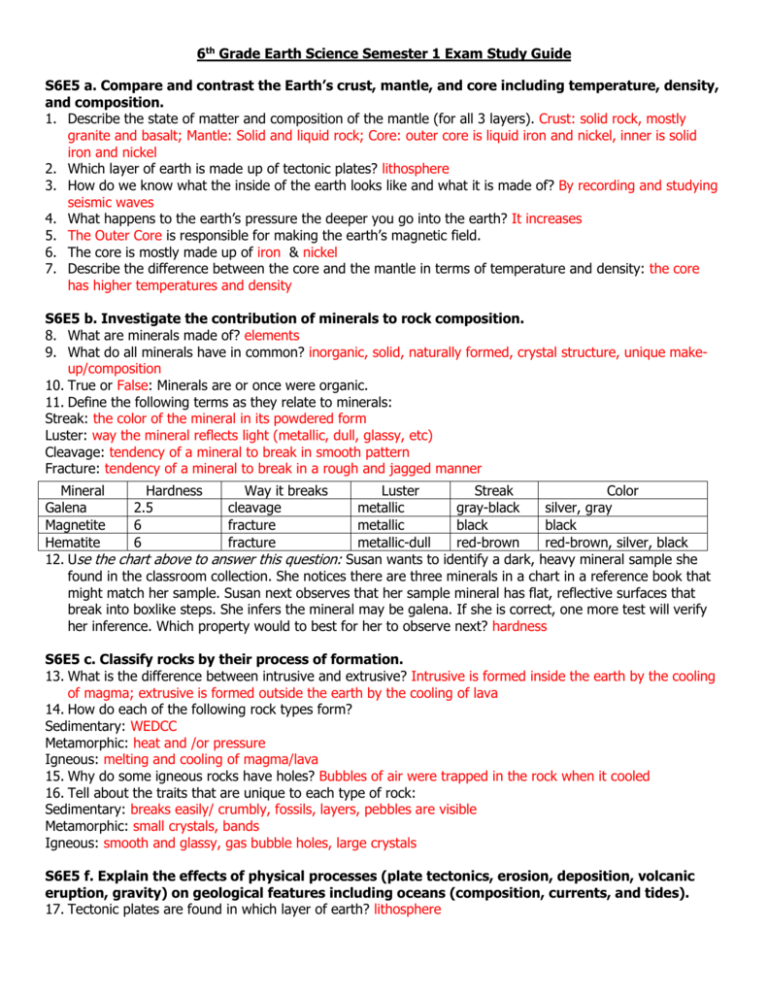
6th Grade Earth Science Semester 1 Exam Study Guide S6E5 a. Compare and contrast the Earth’s crust, mantle, and core including temperature, density, and composition. 1. Describe the state of matter and composition of the mantle (for all 3 layers). Crust: solid rock, mostly granite and basalt; Mantle: Solid and liquid rock; Core: outer core is liquid iron and nickel, inner is solid iron and nickel 2. Which layer of earth is made up of tectonic plates? lithosphere 3. How do we know what the inside of the earth looks like and what it is made of? By recording and studying seismic waves 4. What happens to the earth’s pressure the deeper you go into the earth? It increases 5. The Outer Core is responsible for making the earth’s magnetic field. 6. The core is mostly made up of iron & nickel 7. Describe the difference between the core and the mantle in terms of temperature and density: the core has higher temperatures and density S6E5 b. Investigate the contribution of minerals to rock composition. 8. What are minerals made of? elements 9. What do all minerals have in common? inorganic, solid, naturally formed, crystal structure, unique makeup/composition 10. True or False: Minerals are or once were organic. 11. Define the following terms as they relate to minerals: Streak: the color of the mineral in its powdered form Luster: way the mineral reflects light (metallic, dull, glassy, etc) Cleavage: tendency of a mineral to break in smooth pattern Fracture: tendency of a mineral to break in a rough and jagged manner Mineral Hardness Way it breaks Luster Streak Color Galena 2.5 cleavage metallic gray-black silver, gray Magnetite 6 fracture metallic black black Hematite 6 fracture metallic-dull red-brown red-brown, silver, black 12. Use the chart above to answer this question: Susan wants to identify a dark, heavy mineral sample she found in the classroom collection. She notices there are three minerals in a chart in a reference book that might match her sample. Susan next observes that her sample mineral has flat, reflective surfaces that break into boxlike steps. She infers the mineral may be galena. If she is correct, one more test will verify her inference. Which property would to best for her to observe next? hardness S6E5 c. Classify rocks by their process of formation. 13. What is the difference between intrusive and extrusive? Intrusive is formed inside the earth by the cooling of magma; extrusive is formed outside the earth by the cooling of lava 14. How do each of the following rock types form? Sedimentary: WEDCC Metamorphic: heat and /or pressure Igneous: melting and cooling of magma/lava 15. Why do some igneous rocks have holes? Bubbles of air were trapped in the rock when it cooled 16. Tell about the traits that are unique to each type of rock: Sedimentary: breaks easily/ crumbly, fossils, layers, pebbles are visible Metamorphic: small crystals, bands Igneous: smooth and glassy, gas bubble holes, large crystals S6E5 f. Explain the effects of physical processes (plate tectonics, erosion, deposition, volcanic eruption, gravity) on geological features including oceans (composition, currents, and tides). 17. Tectonic plates are found in which layer of earth? lithosphere 18. Why was Alfred Wegener’s idea of continental drift not accepted? Could not explain “how” the plates moved 19. What is subduction? The process of the ocean floor sinking beneath another plate and back into the mantle 20. Where can we see the results of plate movement? _____________________________________________ 21. What is the MAIN reason that the continents look very different than they did 100 million years ago? The continents has drifted apart from one another on lithospheric plates due to convection currents in the mantle 22. Convection Currents cause the movement of earth’s tectonic or lithospheric plates 23. What evidence supports the theory of continental drift? Fossil clues, rock/mountain clues, climate/glacier clues 24. What geographic force forms u-shaped valleys? glaciers 25. On a topographical map there are curved contour lines that make complete, concentric loops that get smaller and smaller. What is inside the smallest loop? A hill or mountain 26. A contour interval shows the change in elevations (Use the picture to the right to answer the questions #24-26) 27. What is the elevation of the star? 160 28. Which letter represents a steep slope? B 29. What is the contour interval for this topographical map? 20 30. What force causes sediments to be moved from one area to another? Gravity and erosion S6E5 h. Describe soil as consisting of weathered rocks and decomposed organic material. 31. True or False: Organic Matter is made of sand, silt, & clay, does not help plants grow, and is the only ingredient in soil 32. What is humus? Decomposed organic matter 33. Where does soil get its nutrients? When organic matter decays and turns into humus 34. Humus is found in which layer of soil? A horizon/ topsoil 35. What is leaching? When minerals are dissolved and carried from the A horizon to the B horizon S6E6. Students will describe various sources of energy and with their uses and conservation. 36. What is conservation? The process of using resources wisely; reduce, reuse, recycle 37. Define biomass the burning of organic matter, wood, or garbage used to generate energy 38. What is alternative energy? Name the different types of alternative energy. Alternative energy is another energy sources other than fossil fuels; Solar, Wind, Hydroelectric, Biomass, Nuclear, Geothermal 39. I am used mainly in the western US. My energy comes from the heat within the Earth. I can be used for home heating. Water that is piped down to me is turned into steam used to turn turbines and generate energy. What am I? geothermal S6E6 b. Identify renewable and nonrenewable resources. 40. Which of these items was made from a nonrenewable resource? Paper bag, motor oil, cotton shirt, wooden table 41. What is the difference between a renewable and a recyclable resource? Renewable can be replaced by nature in a short amount of time; recyclable is an item that is treated for reuse 42. How can having more people on earth impact our use of fossil fuels? The world’s population is growing and more people are using natural resources faster than they can be replaced. 43. How are fossil fuels formed? From the remains of decayed plants and animals that have been buried millions of years ago 44. Natural gas, oil, and coal are all known as fossil fuels
